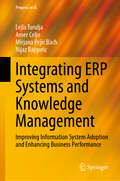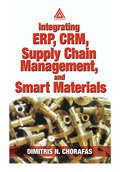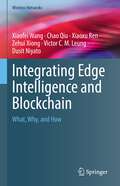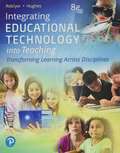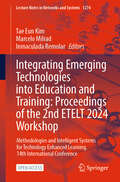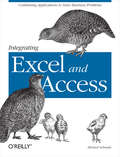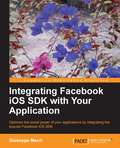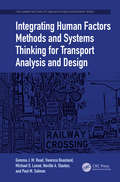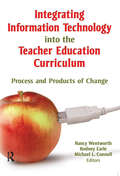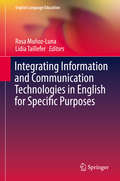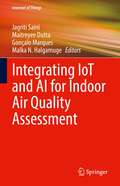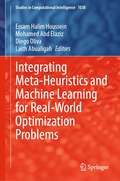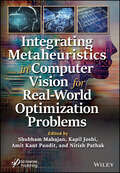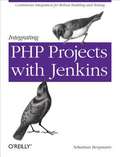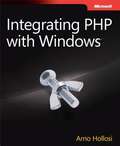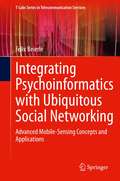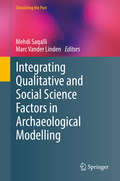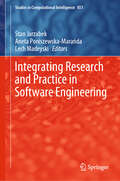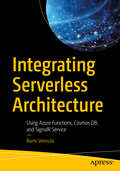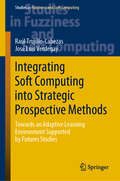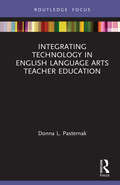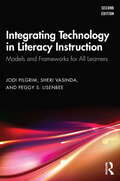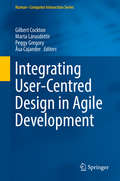- Table View
- List View
Integrating ERP Systems and Knowledge Management: Improving Information System Adoption and Enhancing Business Performance (Progress in IS)
by Lejla Turulja Amer Celjo Mirjana Pejić Bach Nijaz BajgoricThis book combines the Technology Acceptance Model (TAM) and empirical analysis to investigate the adoption of integrated enterprise business information systems (ISs). TAM has been used extensively in the study of ERP acceptance as well as factors in the success or failure of ERP. To date, the adoption of information systems has been studied using various approaches, including Theory of Reasoned Action (TRA) and Theory of Planned Behaviour (TPB), both of which have roots in cognitive psychology (Nicolas et al., 2008). Even though these models have been used in research, the TAM has succeeded in capturing the attention of the information systems community. The book also analyses Knowledge Management Systems (KMSs), illustrating their function as information technologies for storing, improving and distributing intra- and intercompany knowledge. Knowledge management systems are presented as likely the most debated and polemicized topic in the field of knowledge management. Even though these systems are not a crucial aspect of knowledge management, it is evident that all major players in the ERP industry have cloud- and installation-based KMS solutions that they integrate with their ERP modules. After discussing and analysing these topics, the book illustrates how the respective systems can impact business processes and performance. Given its scope, it appeals not only to researchers, but also to practitioners working in these areas of IT.
Integrating ERP, CRM, Supply Chain Management, and Smart Materials
by Dimitris N. ChorafasOrganizations enjoy two kinds of strategic advantages. One is transitory: being in the right place with the right products at the right time. The other comes from having first class management and instituting processes that mobilize an organization, keeping in ahead of the competition. Which would you like to count on for your organization's success?Integrating ERP, CRM, Supply Chain Management, and Smart Materials explores how to create business opportunities and reap savings by: Restructuring and updating of ERP and CRM software as it integrates supply chain management and delivers new killer applications; Evolving opportunities that will develop from the implementation of smart materials, automatic identification, classification systems, and quality assurance projects Auditing the implementation, operation, and maintenance of ERP and CRM software as well as the corrective action taken on the basis of resultsInternet commerce, online supply chain, and advances in technology - all available at increasingly lower costs - make systems of the past obsolete. However, just as new technology creates new opportunities, it can also create unforeseen consequences. By binding a wealth of interdependent issues between the covers of one book, Integrating ERP, CRM, Supply Chain Management, and Smart Materials gives you the tools you need to create proprietary, high value-added solutions.
Integrating Edge Intelligence and Blockchain: What, Why, and How (Wireless Networks)
by Dusit Niyato Xiaofei Wang Victor C. Leung Chao Qiu Xiaoxu Ren Zehui XiongThis book examines whether the integration of edge intelligence (EI) and blockchain (BC) can open up new horizons for providing ubiquitous intelligent services. Accordingly, the authors conduct a summarization of the recent research efforts on the existing works for EI and BC, further painting a comprehensive picture of the limitation of EI and why BC could benefit EI. To examine how to integrate EI and BC, the authors discuss the BC-driven EI and tailoring BC to EI, including an overview, motivations, and integrated frameworks. Finally, some challenges and future directions are explored. The book explores the technologies associated with the integrated system between EI and BC, and further bridges the gap between immature BC and EI-amicable BC.Explores the integration of edge intelligence (EI) and blockchain (BC), including their integrated motivations, frameworks and challenges;Presents how BC-driven EI can realize computing-power management, data administration, and model optimization;Describes how to tailor BC to better support EI, including flexible consensus protocol, effective incentive mechanism, intellectuality smart contract, and scalable BC system tailoring;Presents some key research challenges and future directions for the integrated system.
Integrating Educational Technology Into Teaching
by M. Roblyer Joan HughesA balance of theory, research, and classroom practice helps teachers understand the most effective ways to integrate educational technology Long recognized in the field as the leading educational technology text, Integrating Educational Technology into Teaching links technology integration strategies to specific learning theories, shows pre- and in-service teachers how to plan for technology integration, and offers opportunities to practice integrating technology by designing curriculum to meet teaching and learning needs. Carefully selected exercises, sample lessons, and recommended resources encourage teachers to reflect on their practice as they develop the insights, knowledge, and skills they need to infuse technology across all disciplines. The 8th Edition features updated technology integration and assessment frameworks, helping teachers employ technology in a way that revitalizes students’ interest and engagement in learning. Throughout the book, content is updated to align with the latest ISTE Standards for Educators and Students and showcases the most current tools, methods, and ideas shaping the role of technology in education. Integrating Educational Technology into Teachingis also available via Revel™–an interactive learning environment that enables students to read, practice, and study in one continuous experience.
Integrating Emerging Technologies into Education and Training: Methodologies and Intelligent Systems for Technology Enhanced Learning, 14th International Conference (Lecture Notes in Networks and Systems #1274)
by Marcelo Milrad Tae Eun Kim Inmaculada RemolarThis open access book compiles state-of-the-art research on the development and implementation of advanced learning technologies and AI-assisted tools, showing how they can transform the educational landscape and learning processes in various domains. Covering topics ranging from immersive learning environments to personalized education, it offers insights and practical applications that are shaping the future of classrooms and training programs. This book provides research insights on harnessing emerging technology’s potential to enhance education, and it is an essential reading for educators, researchers, and edu-tech professionals.
Integrating Excel and Access: Combining Applications to Solve Business Problems
by Michael SchmalzIn a corporate setting, the Microsoft Office Suite is an invaluable set of applications. One of Offices' biggest advantages is that its applications can work together to share information, produce reports, and so on. The problem is, there isn't much documentation on their cross-usage. Until now. Introducing Integrating Excel and Access, the unique reference that shows you how to combine the strengths of Microsoft Excel with those of Microsoft Access. In particular, the book explains how the powerful analysis tools of Excel can work in concert with the structured storage and more powerful querying of Access. The results that these two applications can produce together are virtually impossible to achieve with one program separately. But the book isn't just limited to Excel and Access. There's also a chapter on SQL Server, as well as one dedicated to integrating with other Microsoft Office applications. In no time, you'll discover how to:Utilize the built in features of Access and Excel to access dataUse VBA within Access or Excel to access dataBuild connection strings using ADO and DAOAutomate Excel reports including formatting, functions, and page setupWrite complex functions and queries with VBAWrite simple and advanced queries with the Access GUIProduce pivot tables and charts with your data With Integrating Excel and Access, you can crunch and visualize data like never before. It's the ideal guide for anyone who uses Microsoft Office to handle data.
Integrating Facebook iOS SDK with Your Application
by Giuseppe MacrìA tutorial-based guide with chapters focusing on learning and embedding crucial Facebook features.If you are a developer who wishes to develop and monetize your apps on the App store, then this is the book for you. This book assumes you have basic knowledge of iOS programming using Objective-C and XCode, however, prior knowledge of Facebook iOS SDK is not required.
Integrating Human Factors Methods and Systems Thinking for Transport Analysis and Design (The Human Factors, Simulation and Performance Assessment Series)
by Neville A. Stanton Paul M. Salmon Michael G. Lenné Gemma J. Read Vanessa BeanlandGovernments and road safety agencies around the world have either introduced or are considering 'safe system' strategies, a long overdue acknowledgement that different elements of the road system contribute to road safety outcomes. Human factors approaches have a leading role here in both conceptualising the road system as a complex sociotechnical system and in providing practical approaches to support true systems-based countermeasures. This book illustrates the potential for integrating contemporary systems-based human factors methods with modern day driving-assessment methods, such as vehicle instrumentation and driving simulation, to understand and enhance performance in modern day road-transport systems. The book outlines why a fundamental paradigm shift is needed in the way these systems are designed and operated, and illustrates how a wide range of accepted human-factors approaches can be applied successfully to road transport to revolutionise the countermeasure design process. The practical illustrations of these human factors methods are applied to a long-standing road and rail safety issue: rail level crossings, where the road and rail systems intersect. The final chapter of the book highlights the utility of the human factors approach to reducing road trauma and discusses future applications of the approach.
Integrating Information Technology into the Teacher Education Curriculum: Process and Products of Change
by Nancy Wentworth Rodney Earle Michael ConnellAs teaching evolves, teacher education must keep up. This book examines systemic reforms that incorporate new technology to improve any teacher education program.While there are books that address the integration of technology into teaching curricula, very few address the process for teacher education faculty and the systemic reform of a teacher education program. Integrating Information Technology into the Teacher Education Curriculum: Process and Products of Change provides practical examples and suggestions for teacher education departments striving to integrate new technologies into their curriculum. It will help in the effort to motivate faculty to make utilizing new technology a natural strategy for the teachers they are educating. It describes the creation of Design Teams at Brigham Young University&’s McKay School of Education (funded by a PT3 grant) and how these teams worked to successfully reconfigure the school&’s teacher preparation curricula.Integrating Information Technology into the Teacher Education Curriculum examines: how to compose and create a curriculum design team-including both teacher education and content-specific methods instructors training and collaboration opportunities that focus on the infusion of technology how to facilitate alignment among a university, cooperating school districts, the State Office of Education, and other available teacher preparation programs specific case examples of the redevelopment of teacher education courses by the instructors who teach them the process of changing a technology course required by the teacher education program the process of extending grant activities to the university&’s partner school districts and the State Office of EducationFrom the editors:Preparing tomorrow&’s teachers to use technology in schools is a complex endeavor requiring the infusion of technology into curriculum and instructional practices at all levels of the pre-service program. In many early teacher education programs, prospective teachers took a computer literacy class separate from content methods classes and rarely engaged in real collaboration on how schoolteachers could integrate technology into authentic learning experiences. By focusing merely on how to use computers, technology training failed by not addressing how to teach students more effectively using a variety of technological tools. What teachers need to know most is how to teach content more effectively. Technology integration should cause teachers to develop different perspectives through rethinking teaching and learning. Teaching with technology causes teachers to confront their established beliefs about instruction and their traditional roles as classroom teachers.
Integrating Information and Communication Technologies in English for Specific Purposes (English Language Education #10)
by Rosa Muñoz-Luna Lidia TailleferThis book fills the need for a text that integrates Information and Communication Technologies (ICTs) into English for Specific Purposes (ESP). It offers insights on current methodological principles in ESP in both academic and professional contexts, drawing on authentic teaching and learning situations, and analyses best practice guidelines. Part I begins with ESP pedagogical principles and technological practice in order to focus on its two main branches: English for Academic Purposes, which includes linguistic skills and students’ needs, and English for Occupational Purposes, specifically looking at Business, Medical and Translators courses. This book is a great resource for ESP researchers, educators and students, because it provides case studies of how ICTs can be used in English for multiple purposes. Authors present their experiences of integrating tools into their instructions, with each chapter contributing unique pedagogical implications.
Integrating IoT and AI for Indoor Air Quality Assessment (Internet of Things)
by Malka N. Halgamuge Maitreyee Dutta Gonçalo Marques Jagriti SainiThis book presents Internet of Things (IoT) solutions monitoring and assessing a variety of applications areas for indoor air quality (IAQ). This book synthesizes recent developments, presents case studies, and discusses new methods in the area of air quality monitoring, all the while addressing public health concerns. The authors discuss the issues and solutions, including IoT systems that can provide a continuous flow of data retrieved from cost-effective sensors that can be used in multiple applications.The authors present the leading IoT technologies, applications, algorithms, systems, and future scope in this multi-disciplinary domain.
Integrating Meta-Heuristics and Machine Learning for Real-World Optimization Problems (Studies in Computational Intelligence #1038)
by Diego Oliva Mohamed Abd Elaziz Laith Abualigah Essam Halim HousseinThis book collects different methodologies that permit metaheuristics and machine learning to solve real-world problems. This book has exciting chapters that employ evolutionary and swarm optimization tools combined with machine learning techniques. The fields of applications are from distribution systems until medical diagnosis, and they are also included different surveys and literature reviews that will enrich the reader. Besides, cutting-edge methods such as neuroevolutionary and IoT implementations are presented in some chapters. In this sense, the book provides theory and practical content with novel machine learning and metaheuristic algorithms. The chapters were compiled using a scientific perspective. Accordingly, the book is primarily intended for undergraduate and postgraduate students of Science, Engineering, and Computational Mathematics and can be used in courses on Artificial Intelligence, Advanced Machine Learning, among others. Likewise, the material can be helpful for research from the evolutionary computation, artificial intelligence communities.
Integrating Metaheuristics in Computer Vision for Real-World Optimization Problems
by Shubham Mahajan Amit Kant Pandit Kapil Joshi Nitish PathakA comprehensive book providing high-quality research addressing challenges in theoretical and application aspects of soft computing and machine learning in image processing and computer vision. Researchers are working to create new algorithms that combine the methods provided by CI approaches to solve the problems of image processing and computer vision such as image size, noise, illumination, and security. The 19 chapters in this book examine computational intelligence (CI) approaches as alternative solutions for automatic computer vision and image processing systems in a wide range of applications, using machine learning and soft computing. Applications highlighted in the book include: diagnostic and therapeutic techniques for ischemic stroke, object detection, tracking face detection and recognition; computational-based strategies for drug repositioning and improving performance with feature selection, extraction, and learning; methods capable of retrieving photometric and geometric transformed images; concepts of trading the cryptocurrency market based on smart price action strategies; comparative evaluation and prediction of exoplanets using machine learning methods; the risk of using failure rate with the help of MTTF and MTBF to calculate reliability; a detailed description of various techniques using edge detection algorithms; machine learning in smart houses; the strengths and limitations of swarm intelligence and computation; how to use bidirectional LSTM for heart arrhythmia detection; a comprehensive study of content-based image-retrieval techniques for feature extraction; machine learning approaches to understanding angiogenesis; handwritten image enhancement based on neutroscopic-fuzzy. Audience The book has been designed for researchers, engineers, graduate, and post-graduate students wanting to learn more about the theoretical and application aspects of soft computing and machine learning in image processing and computer vision.
Integrating Omics Data
by George Tseng Debashis Ghosh Xianghong Jasmine ZhouIn most modern biomedical research projects, application of high-throughput genomic, proteomic, and transcriptomic experiments has gradually become an inevitable component. Popular technologies include microarray, next generation sequencing, mass spectrometry and proteomics assays. As the technologies have become mature and the price affordable, omics data are rapidly generated, and the problem of information integration and modeling of multi-lab and/or multi-omics data is becoming a growing one in the bioinformatics field. This book provides comprehensive coverage of these topics and will have a long-lasting impact on this evolving subject. Each chapter, written by a leader in the field, introduces state-of-the-art methods to handle information integration, experimental data, and database problems of omics data.
Integrating PHP Projects with Jenkins
by Sebastian Bergmann<p>Today’s web applications require frequent updates, not just by adding or upgrading features, but by maintaining and improving the software’s existing code base as well. This concise book shows PHP developers how to use the popular Jenkins continuous integration server to monitor various aspects of software quality through continuous integration and continuous inspection.</p>
Integrating PHP with Windows®
by Arno HollosiAccess and run Windows® web and database technologies with PHP Take your PHP programming skills deep into Windows--and build PHP applications that run efficiently and effectively on an array of Windows technologies. Packed with hands-on exercises, this in-depth guide shows you how to use PHP to interact with Internet Information Services 7.5 (IIS), Microsoft® SQL Server® 2008, Microsoft Exchange Server 2010, and Active Directory®. You'll quickly learn how to apply best practices for running PHP applications in a Windows environment. Discover how to: Use Microsoft SQL Server as the backend database for PHP applications Set up full-text search on SQL Server to help users find data quickly Improve PHP application performance with IIS caching techniques Configure IIS to help secure your PHP applications against attacks Manage users and groups in Active Directory with a PHP application Create a PHP LDAP browser to search for and view Active Directory data Program Exchange Server with PHP, using Exchange Web Services (EWS)
Integrating Psychoinformatics with Ubiquitous Social Networking: Advanced Mobile-Sensing Concepts and Applications (T-Labs Series in Telecommunication Services)
by Felix BeierleThis book deepens the understanding of people through smartphone data obtained via mobile sensing and applies psychological insights for social networking applications. The author first introduces TYDR, an application for researching smartphone data and user personality. A novel, structured privacy model for mobile sensing applications is developed and the obtained empirical results help researchers gauge what data they can expect users to share in daily-life studies. The new research findings, the concept of mobile sensing, and psychological insights about the formation and structure of real-life social networks are integrated into the field of social networking. Finally, for this novel integration, the author presents concepts, decentralized software architectures, and fully realized prototypes that recommend new contacts, media, and locations to individual users and groups of users.
Integrating Qualitative and Social Science Factors in Archaeological Modelling (Computational Social Sciences)
by Marc Vander Linden Mehdi SaqalliThis book covers the methodological, epistemological and practical issues of integrating qualitative and socio-anthropological factors into archaeological modeling. This text fills the gap between conceptual modeling (which usually relies on narratives describing the life of a past community) and formalized/computer-based modeling which are usually environmentally-determined. Methods combining both environmental and social issues through niche and agent-based modeling are presented. These methods help to translate data from paleo-environmental and archaeological society life cycles (such as climate and landscape changes) into the local spatial scale. The epistemological discussions will appeal to readers as well as the resilience socio-anthropological factors provide facing climatic fluctuations. Integrating Qualitative and Social Science Factors in Archaeological Modelling will appeal to students and researchers in the field.
Integrating Research and Practice in Software Engineering (Studies in Computational Intelligence #851)
by Lech Madeyski Stan Jarzabek Aneta Poniszewska-MarańdaIn this book, the authors highlight recent findings that hold the potential to improve software products or development processes; in addition, they help readers understand new concepts and technologies, and to see what it takes to migrate from old to new platforms. Some of the authors have spent most of their careers in industry, working at the frontiers of practice-based innovation, and are at the same time prominent researchers who have made significant academic contributions. Others work together with industry to test, in industrial settings, the methods they’ve developed in the lab. The choice of subject and authors represent the key elements of this book. Its respective chapters cover a wide range of topics, from cloud computing to agile development, applications of data science methods, re-engineering of aging applications into modern ones, and business and requirements engineering. Taken together, they offer a valuable asset for practitioners and researchers alike.
Integrating Serverless Architecture: Using Azure Functions, Cosmos DB, and SignalR Service
by Rami VemulaDesign, develop, build, and deliver an end-to-end serverless architecture by leveraging Azure services, frameworks, and tools. This book offers a holistic approach, guiding you through the design and development of a Twitter Bot application, while leveraging Azure Functions.Integrating Serverless Architecture begins with an overview of serverless computing and getting started with Azure Functions. Here, you will create a Twitter bot function which scans Twitter for the latest tweets and makes use of dependency injection. Further, you will learn about Azure Cosmos DB where you will cover its change feed mechanism and the repository pattern. You will create a Cosmos DB trigger-based tweet notifier function, which will broadcast the latest tweets to connected clients. You will explore the basics of Azure Service Bus and create a tweet scheduler function, which will prioritize different keywords for the Twitter bot function. Along the way, you will debug, deliver, and test the functions in the Azure environment.This book shows you how to secure your Azure Function secrets with the help of Azure Key Vault. To further your understanding of the technology, you will learn logging and exception handling in Azure Functions.Later in the book, you will build a Twitter bot web application by using ASP.NET Core and Materialize CSS, which will interact with several HTTP-based Azure Functions. The Twitter bot web application allows users to log in through the Twitter Identity Provider, subscribe to different keywords/hashtags, and browse the latest tweets based on subscriptions. You will get started with SignalR Service and integrate it with Azure Functions and web applications. Towards the end you will go through app service authentication on Azure Functions and discover how to configure continuous integration and delivery to Azure Functions. After reading this book, you will be able to understand the steps involved in design, development, and delivery of a workflow using Azure Functions.What You Will LearnDesign and develop a Twitter bot application using Azure Functions with Azure Web App Service as the front endLeverage Azure Cosmos DB as data storage and trigger notifications using its change feed mechanismStore and retrieve secrets from Azure Key VaultIntegrate Azure Functions with Azure SignalR Service to broadcast real-time messagesSecure Azure Functions by enabling Twitter identity authentication using built-in App Service authenticationBuild a continuous integration and continuous delivery pipeline for Azure Functions using Visual Studio Team Services (VSTS)Who This Book Is ForDevelopers, software engineers, and architects who design and manage infrastructures and build applications by leveraging Microsoft cloud services.
Integrating Social Media into Information Systems: Requirements, Gaps, and Potential Solutions (G - Reference, Information and Interdisciplinary Subjects)
by Parisa Roshan Isaac R. Porche III Ryan Andrew Brown Astrid Stuth Cevallos Osonde A. Osoba Joshua Mendelsohn Douglas Douglas Yeung John Bordeaux Timothy R. Gulden Laura Kupe Luke J. Matthews Katharine Sieck Sarah SolimanThis report examines the technical challenges associated with incorporating bulk, automated analysis of social media information into procedures for vetting people seeking entry into the United States. The authors identify functional requirements and a framework for operational metrics for the proposed social media screening capabilities and provide recommendations on how to implement those capabilities.
Integrating Soft Computing into Strategic Prospective Methods: Towards an Adaptive Learning Environment Supported by Futures Studies (Studies in Fuzziness and Soft Computing #387)
by José Luis Verdegay Raúl Trujillo-CabezasThis book discusses how to build optimization tools able to generate better future studies. It aims at showing how these tools can be used to develop an adaptive learning environment that can be used for decision making in the presence of uncertainties. The book starts with existing fuzzy techniques and multicriteria decision making approaches and shows how to combine them in more effective tools to model future events and take therefore better decisions. The first part of the book is dedicated to the theories behind fuzzy optimization and fuzzy cognitive map, while the second part presents new approaches developed by the authors with their practical application to trend impact analysis, scenario planning and strategic formulation. The book is aimed at two groups of readers, interested in linking the future studies with artificial intelligence. The first group includes social scientists seeking for improved methods for strategic prospective. The second group includes computer scientists and engineers seeking for new applications and current developments of Soft Computing methods for forecasting in social science, but not limited to this.
Integrating Technology in English Language Arts Teacher Education (Routledge Research in Teacher Education)
by Donna L. PasternakIntegrating Technology in English Language Arts Teacher Education investigates the technology practices teacher candidates in the US are being introduced to, how they are using these practices in classrooms, and how technology can be effectively integrated into English teacher education programs. By drawing upon findings from extensive longitudinal studies into teacher education programs in the US, this timely volume addresses critical themes relating to the integration of technology in education, including: • Teaching with technology • Technology for collaboration • Technology for individualized learning and assessment By analyzing the experiences of teacher educators and candidates, and offering detailed analysis of the content, practices, and skills being taught to pre-service English teachers, Pasternak examines the entities that drive or inhibit the adoption of technology into the secondary English language arts (ELA) curriculum. This volume will resonate with an international audience of post-graduate scholars and researchers interested in the fields of teacher education, English language arts, and the relationship between technology and classroom practice.
Integrating Technology in Literacy Instruction: Models and Frameworks for All Learners
by Jodi Pilgrim Sheri Vasinda Peggy S. LisenbeeIn the second edition, this text has been updated to address changing literacies surrounding students and the continued importance of effective communication using technology tools in K-12 classrooms. Technology has the power and potential to transform teaching and learning in classrooms and to promote active learning, interaction, and engagement through readily available tools and applications. While both technologies and research in literacy education rapidly evolve, this book presents lasting frameworks for teachers to effectively evaluate and implement digital tools to enhance classroom literacies and learning. Through the lens of Universal Design for Learning (UDL), this text equips educators to develop inclusive learning environments that support the needs and desires of all literacy learners through the integration of technology and literacy instruction. This text presents a range of current models and frameworks, including SAMR, RAT, PICRAT, T3, TPACK, TIPC, and EMSCI. The new edition of this book has been updated to include: Alignment with ISTE standards in each chapter Updates from the 2024 UDL Guidelines 3.0 Updates from the most recent 2024 National Educational Technology Plan Updated technology applications, including AI and its impact Tools for teaching through remote and distance learning Each chapter includes prompts for reflection and discussion to encourage readers to consider ways literacy and technology can enable teachers to become agents of change. This book will be especially beneficial for pre-service undergraduate and graduate teacher candidates, as well as ISTE certified educators and those seeking certification.
Integrating User-Centred Design in Agile Development
by Gilbert Cockton Marta Lárusdóttir Peggy Gregory Åsa CajanderThis book examines the possibilities of incorporating elements of user-centred design (UCD) such as user experience (UX) and usability with agile software development. It explores the difficulties and problems inherent in integrating these two practices despite their relative similarities, such as their emphasis on stakeholder collaboration. Developed from a workshop held at NordiCHI in 2014, this edited volume brings together researchers from across the software development, UCD and creative design fields to discuss the current state-of-the-art. Practical case studies of integrating UCD in Agile development across diverse contexts are presented, whilst the different futures for UCD and other design practices in the context of agile software development are identified and explored. Integrating User Centred Design in Agile Development will be ideal for researchers, designers and academics who are interested in software development, user-centred design, agile methodologies and related areas.
